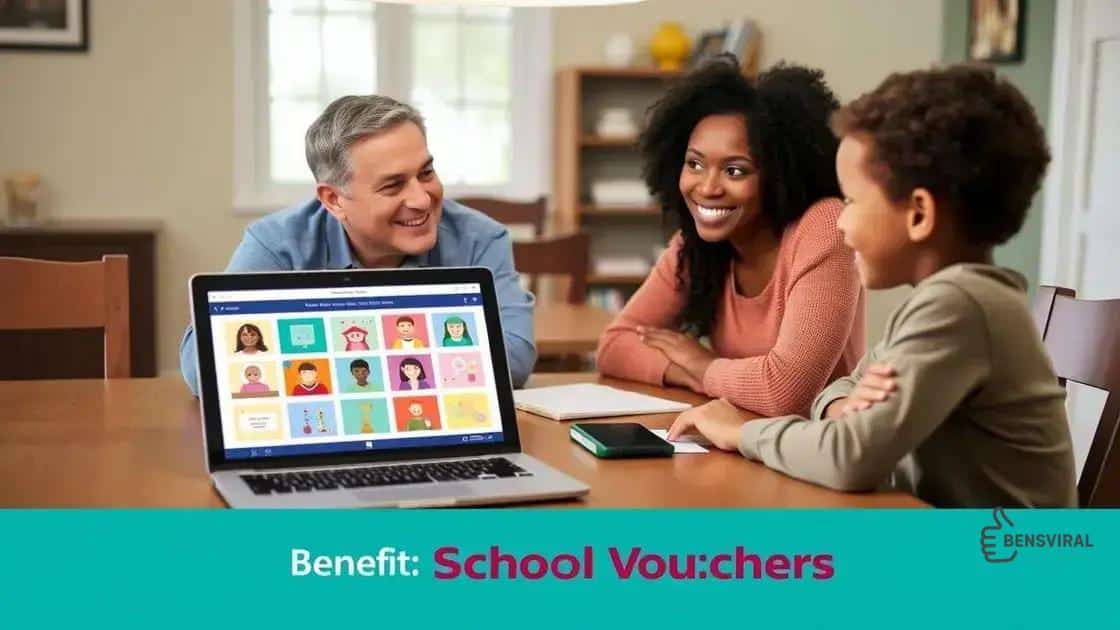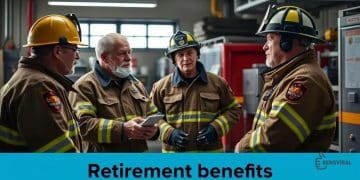Texas initiatives for school voucher distribution

Texas initiatives for school voucher distribution provide families with educational choices, aiming to improve access and quality, while facing challenges such as funding impacts on public schools and equity concerns for low-income families.
Texas initiatives for school voucher distribution are making waves in the education landscape, stirring debate and curiosity. Have you ever wondered how these programs affect students and resources? Let’s dive in and explore!
Understanding school voucher programs
Understanding school voucher programs is essential for grasping the current educational landscape in Texas. These programs are designed to provide families with the freedom to choose where their children attend school.
At their core, school vouchers are funds allocated by the state that parents can use to pay for tuition at private schools instead of public schools. This initiative aims to enhance educational opportunities and promote competition among schools.
How Do School Vouchers Work?
When families apply for school vouchers, they typically receive a certain amount of money based on their financial situation or the school district they reside in. Parents can then use these funds toward tuition, fees, and other costs associated with enrolling their child in a private school.
Key Benefits of School Voucher Programs
- Increased parental choice in education.
- Potential improvements in educational quality due to competition.
- Accessibility for families in underperforming school districts.
While the concept of school vouchers is often met with mixed feelings, many supporters argue that they offer much-needed alternatives for families dissatisfied with public education.
Types of School Vouchers
There are generally two types of school voucher programs: full vouchers and partial vouchers. Full vouchers cover the entire cost of private tuition, while partial vouchers may only cover a portion of the expenses.
Understanding the different types of vouchers is vital for parents considering this option. Additionally, some states may have unique regulations regarding eligibility and funding that can influence decision-making.
There’s also a focus on transparency and accountability. Many advocate for policies that ensure schools accepting vouchers are held to certain standards of performance and financial responsibility.
Ultimately, as more states like Texas consider or enhance their school voucher programs, it’s crucial for families to stay informed about the specifics and implications of these initiatives. By understanding how school vouchers function, parents can make informed decisions that best suit their children’s educational needs. Families must weigh the options and consider how each program aligns with their values and educational goals.
The impact of vouchers on public schools
The impact of vouchers on public schools is a topic of lively debate among educators and policymakers. Vouchers can change how public schools function, influencing funding, competition, and educational quality.
When students use vouchers to enroll in private schools, public schools often receive less funding. This can lead to budget cuts and larger class sizes, affecting the quality of education provided to remaining students. With fewer resources, public schools may struggle to maintain programs and services.
Competitive Pressure and Innovation
On the other hand, vouchers create a competitive environment. Public schools may feel pressure to improve their educational offerings in order to retain students. This can lead to innovative teaching methods and programs designed to meet students’ needs better.
Potential Benefits for Public Schools
- Increased focus on student performance.
- Adoption of new teaching strategies to attract families.
- Potential funding for programs targeting at-risk students.
Yet, the effects vary widely by district and community. Some public schools may flourish in this competitive landscape, while others may face significant challenges.
Some studies suggest that the introduction of voucher programs can lead to mixed outcomes for public schools. For example, while some schools enhance their performance, others may see a decline in overall quality. Moreover, families using vouchers often choose schools based on factors like academic performance and safety, which can shift the demographic makeup of both public and private institutions.
Ultimately, the relationship between vouchers and public education is complex. Understanding these dynamics is crucial for policymakers who aim to balance school choice with ensuring a robust public education system.
Benefits for families and students

Benefits for families and students participating in school voucher programs are significant and can greatly enhance educational opportunities. These programs open the door for families to choose schools that align with their children’s needs and preferences.
One major advantage is the ability to select from a variety of educational environments. Parents can consider factors like academic performance, educational philosophy, and extracurricular activities when choosing a school. This choice can lead to a more tailored educational experience for students.
Improved Educational Outcomes
Many studies indicate that students who use vouchers might experience better educational outcomes. They often have access to better resources and smaller class sizes, which can contribute to more personalized instruction.
- Access to specialized programs and services.
- Increased parental involvement in education.
- Opportunities for skill development in smaller settings.
Additionally, vouchers can provide families with more financial flexibility. This can be particularly beneficial for low-income families who wish to enroll their children in higher-performing schools that may charge tuition.
Community Engagement and Satisfaction
School vouchers can also foster a sense of community engagement. Parents who invest time and effort in choosing their child’s school are often more involved in their education. This involvement can lead to increased satisfaction with the schooling system overall.
Moreover, by participating in voucher programs, families can shape the educational landscape. When parents support specific initiatives or schools, they communicate their values and priorities, influencing educational policy.
Overall, the benefits of school vouchers for students and families are profound. These programs not only provide greater choice but also encourage engagement and satisfaction within the educational system, laying the groundwork for a bright future.
Current initiatives in Texas
Current initiatives in Texas regarding school voucher distribution are reshaping how education is delivered in the state. These initiatives aim to provide greater choice and flexibility for families while addressing the varied educational needs of students.
One prominent initiative is the Texas Education Savings Account (ESA) program. This program allows families to use state funds for various educational expenses, including private school tuition, tutoring, and online courses. By providing families with direct access to educational resources, the ESA program empowers parents to select the best options for their children.
Legislative Developments
In recent years, Texas lawmakers have introduced several bills aimed at expanding voucher programs. These legislative efforts often emphasize the goal of enhancing educational quality and increasing school choice.
- Proposals for statewide voucher programs.
- Funding allocations for low-income families.
- Options for students with disabilities.
As these proposals progress, community members and stakeholders frequently engage in discussions about the potential impacts of voucher systems on public and private education.
Impact on School Districts
Current initiatives in Texas have sparked reactions from various school districts. Some districts support school choice and recognize the potential benefits of competition. Others express concern about possible funding losses and their ability to serve remaining students effectively.
These initiatives also push public schools to innovate and improve their offerings. Districts are exploring new programs to enhance student engagement and academic performance, ensuring they remain attractive alternatives for families.
Overall, the landscape of school vouchers and educational initiatives in Texas is dynamic. As new proposals emerge, the dialogue around educational choice continues to evolve, reflecting the diverse needs and opinions of Texas families.
Challenges and criticisms of school vouchers
Challenges and criticisms of school vouchers are important to consider when discussing this educational approach. While vouchers aim to empower families, they also bring forth various issues that can affect communities and educational systems.
One significant challenge is the concern over funding. When students leave public schools to attend private institutions using vouchers, public schools may lose vital resources. This can lead to larger class sizes and reduced program offerings, which might negatively impact the quality of education for remaining students.
Equity and Access Issues
Critics also point out that school vouchers do not always provide equal access for all families. Many low-income families may still struggle to utilize vouchers effectively. For instance, some private schools may have admission processes that create barriers for disadvantaged students, limiting their options.
- High tuition fees at certain private schools.
- Lack of transportation options for students in rural areas.
- Limited availability of special programs for students with disabilities.
This raises concerns about whether vouchers truly promote fairness in education or simply favor those who are already better off.
Quality of Education
Another point of contention is the quality of education in non-public schools. While some private schools may offer exceptional programs, others might lack proper oversight or accountability. This can lead to varying educational outcomes for students across different schools.
In addition, public schools often have standardized testing and accountability measures that may not apply to private institutions. Critics argue that this discrepancy can undercut efforts to maintain educational quality and ensure all students receive a well-rounded education.
Lastly, the implementation of school voucher programs can be accompanied by political and social controversies. Debates often arise over the best ways to allocate funding and resources for education, with strong opinions on both sides. This complexity can make it difficult to navigate the changes required to create effective educational reform.
FAQ – Frequently Asked Questions about School Voucher Programs
What are school vouchers?
School vouchers are funds provided by the government that families can use to pay for tuition at private schools instead of public schools.
How do school vouchers benefit families?
Vouchers give families more choices regarding their children’s education, enabling them to select schools that best meet their needs and preferences.
What challenges do school vouchers face?
School vouchers face challenges such as funding issues for public schools, equity concerns regarding access for low-income families, and variations in the quality of education provided by private schools.
How can school vouchers impact public education?
Vouchers can lead to reduced funding for public schools, which may result in larger class sizes and fewer resources, impacting the quality of education for remaining students.






